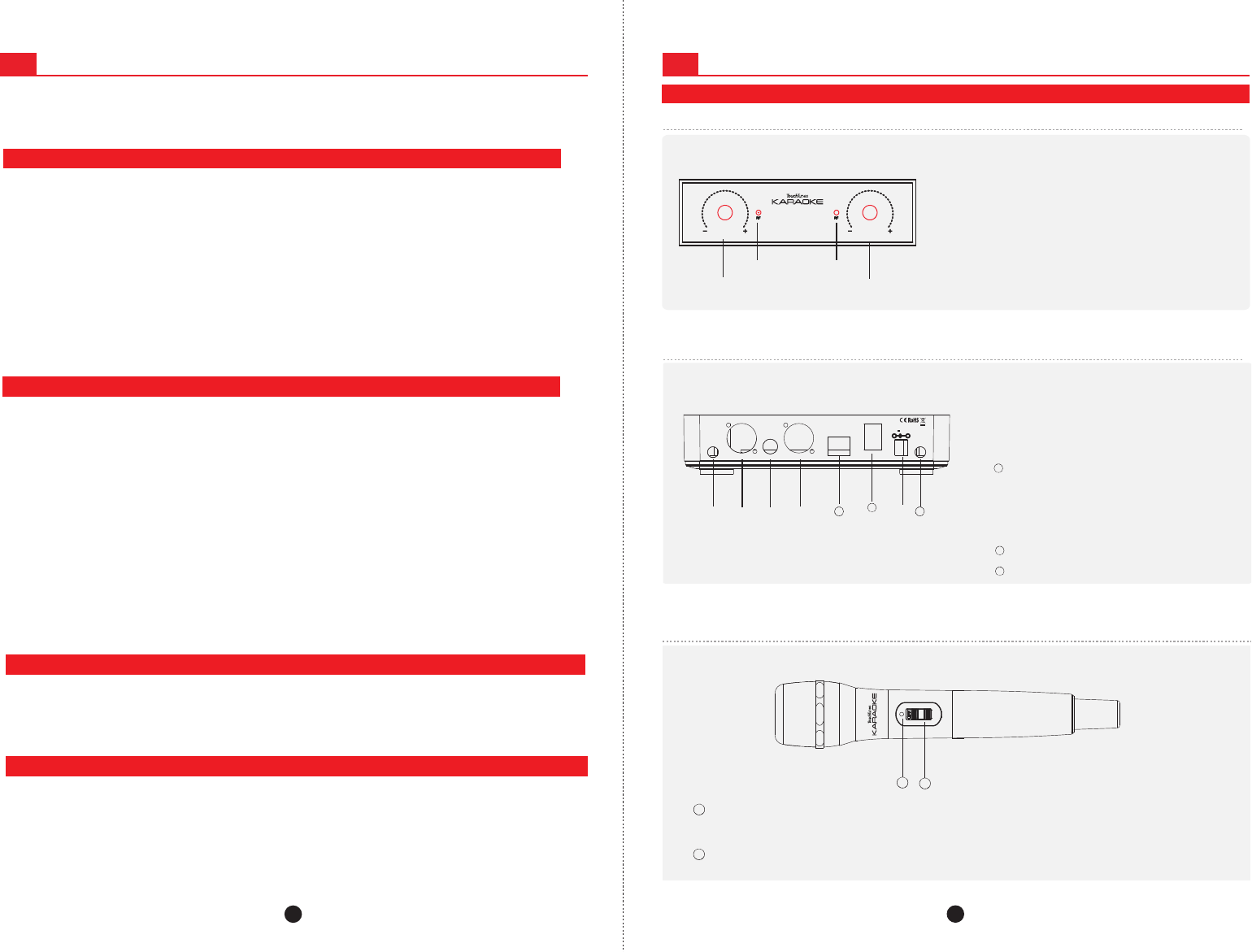TouchTunes Interactive Networks TT-7220 WIRELESS MICROPHONE User Manual
TouchTunes Interactive Networks WIRELESS MICROPHONE
User Manual

WIRELESS MICROPHONE
TT-7220
USER MANUAL

6
Welcome to use series wireless microphone TT-7220, in order to exert the best performance of
this product, please read the user manual detailedly before using it.
Features
Specification
UHF Wireless Microphone
·UHF frequency band features interference-free reception
·Long operating range up to 50 meters in open area
·Transmitter features excellent audio companding circuit and high quality cardioid capsule for best sound quality
and maximum feedback rejection
·Powered by 2pcs of 1.5V batteries for convenient use
·Advanced pilot frequency lock function can better avoid interference and eliminate the on/off impulsive noise
·Balanced(XLR)and unbalanced (6.3mm) output for convenient connection with various audio equipment
·Receiver adopts quartz frequency multiplication fixed frequencies for simple and convenient use
Frequency Range: 911.05MHz-927.05MHz
Frequency Control: PLL/ Quartz Frequency multiplication
Frequency Steadiness: ±0.005%
Modulation Mode: FM
Number of Channels: fixed frequency
Receiving Mode: dual conversion
Frequency Response: 60Hz-15kHz
Max. Frequency Deviation: ±45kHz
S/N Ratio: >80dB
THD: <0.5%
Receiving Sensitivity: -80dBm
Dynamic Range: >100dB
Receiver Audio Output: unbalanced + balanced
Transmit Power: 1mW
Transmitter Power Supply: 3V(2pcs 1.5V batteries)
Transmitter Battery Play Time: approx. 10hrs (depending
on the battery)
Operating Range: 50m in open area
Operating Temperature: -20℃~60℃
TT-7220
2
Application
Product Content
• Campus meeting, entertainment host, speech, karaoke
Receiver 1pc
Handheld Transmitter 2pcs
8
Operating Instruction
Front Side
Rear Side
Handheld Microphone
13
14
UHF Wireless Microphone
① Volume Adjustment Knob A: to adjust the output volume
of the receiver
② RF Signal Indicator A: indicate the receiving signal
③ RF Signal Indicator B: indicate the receiving signal
④ Volume Adjustment Knob B: to adjust the output
volume of the receiver
⑤
⑥
⑦
⑧
Antenna B
XLR Balanced Output Socket B
6.3MM Unbalanced Output Socket
XLR Balanced Output Socket A
Power Button: press the button to “ON” position,
the receiver is turned on
DC Power Input Port: to connect with the power
adaptor
Antenna A
RJ45 connector
Power Indicator: when the LED indicator keeps on green, it means the battery power is normal; when the
indicator is flickering, it means the battery power is low and need to replace timely
Power Switch: push the switch to “ON” position, the transmitter is turned on and the power indicator lights up
green
LED
9
⑩
11
TT-7220
12
①
②③
④
VOL A VOL B
UH F W IR E LES S M IC R OP H ONE
TT- 72 20
⑤ ⑥ ⑦ ⑧ ⑩
911
BAL OUT A
I / O
BAL OUT B
ANT. AANT.B OFF
ON
UNBALANCED OUT
12V 500mA
-
+
Made in China
12
13 14
TT-72 20

7
UHF Wireless Microphone
Operating Instruction
Notice
1 Connect the output end of the standard power adaptor to the receiver DC power input port ⑩, and connect the other
end to the AC power socket
2. When connecting the receiver unbalanced audio output socket ⑦ or balanced “XLR” output socket ⑥ ⑧ to the input
socket of the amplifying device, please turn down the volume of the amplifying device first
3. Then turn on the power switch ⑨on the rear side of the receiver
4. Open the handheld transmitter tail pipe or the battery cover of the body-pack transmitter, put in 2pcs AA batteries
5. Turn on the power switch of the handheld transmitter the indicator turns green, transmitter is turned on)
6. Please adjust the volume adjustment knob ①/④ in front of the receiver for the desired sound effect
7. When installing the receiver, keep an appropriate distance away from the metal surface, walls and other RF devices
.
/
1. Acoustic feedback (howling) prevention
Turn down the volume and do not point the microphone at the speaker, keep an appropriate distance between the
microphone and the speaker, and do not cover the microphone headcase with your hand
2. When the microphone is close to the sound source, it will generate the near-field effect (low frequency response is
enhanced), if it is used properly, it can make the low-frequency sound effect more full and soft
14
TT-7220
FCC warning statement
This device complies with Part 15 of the FCC rules.
Operation is subject to the following two conditions:
1)this device may not cause harmful interference, and
2) this device must accept any interference received,
including interference that may cause undesired operation.
Changes or modifications not expressly approved
by the party responsible for compliance could void the
user's authority to operate the equipment.
Note: This equipment has been tested and found to comply
with the limits for a Class B digital device, pursuant to part
15 of the FCC Rules. These limits are designed to provide
reasonable protection against harmful interference in a residential
installation. This equipment generates uses and can radiate radio
frequency energy and, if not installed and used in accordance with
the instructions, may cause harmful interference to radio communications.
However, there is no guarantee that interference will not occur in a
particular installation. If this equipment does cause harmful interference
to radio or television reception, which can be determined by turning the
equipment off and on, the user is encouraged to try to
by one or more of the following measures:
-Reorient or relocate the receiving antenna.
-Increase the separation between the equipment and receiver.
-Connect the equipment into an outlet on a circuit different
-Consult the dealer or an experienced radio/TV technician for help.
from that to which the receiver is connected.
correct the interference